In the series “Job Profiles”, we talk to various members of the InterNations team about their position and the work that they do.
For this installment, we interviewed Salim, a Lebanese expat and graphic designer working in our Content & Communications Department.

What do you do at InterNations, and how long have you been working here?
I’m a corporate graphic designer, and I started working at InterNations in July 2017. For the past two and a half years, I’ve been handling everything related to the corporate aspect of visual and graphic design.
Which tasks and responsibilities does your job involve?
Each department, each team, requires different types of design; I support them with whatever they need.
In the Content & Communications Department, the Expat Insider survey — one of the world’s largest expat surveys — is a big project that takes up a lot of my time. It involves many related tasks, starting with promoting the questionnaire. At this stage, we have to come up with ideas for how to promote the survey, such as social media banners, and then we need to translate this idea into concrete designs. But that’s just the first step.
The second, much bigger, part is the survey report itself, which we publish as a PDF every year. Usually I work on different design concepts first and then present them to other team members, for example, at our weekly design meeting. When we’ve selected one of these concepts, the real work starts: designing the new templates for the report, the infographics, and so on. Then comes the phase when the report is finalized. This is a full-time job on its own and it takes me about two weeks. And then there are other reports for PR campaigns based on Expat Insider data, such as the Digital Life Report and the Expat City Ranking.
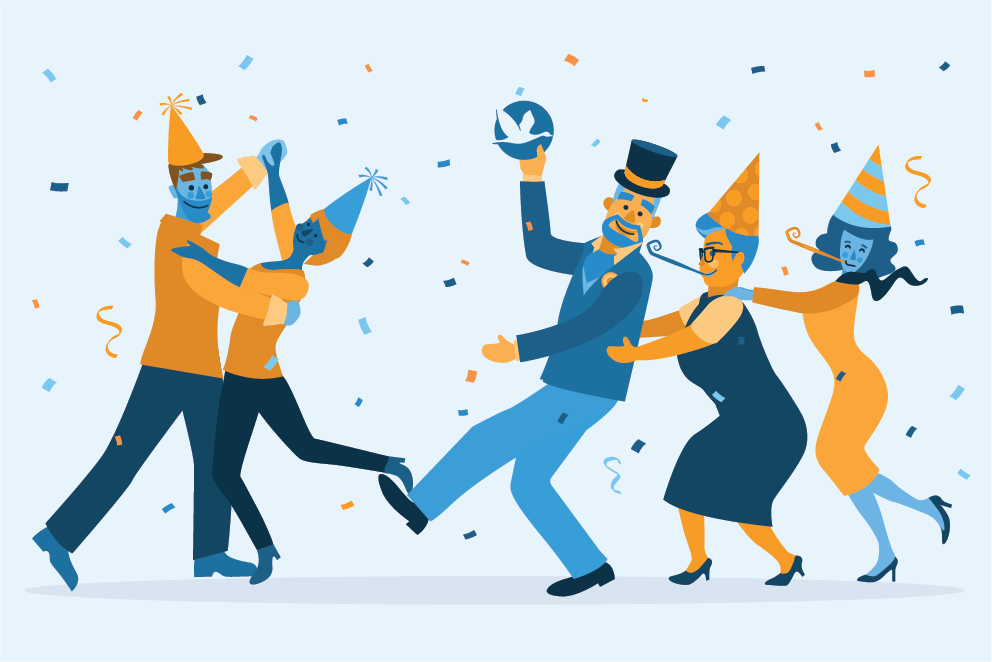
Aside from that, I create lots of illustrations for the Product Management Department. They are often based on the six characters who represent the InterNations brand and the various challenges that expats face. These illustrations are used on our website, in the app, or for emails; it depends. However, we have certain guidelines on how to use them; you can’t just use them anywhere for any purpose. They are supposed to tell a story to guide you through the InterNations platform. I quite like working on the illustrations — it’s fun!
I also rebranded the InterNations Event Kit for the Community Engagement Team, updating the design for all the materials we use at our official events around the world, for example, the welcome banners featuring our company name and logo. The team often asks me to create new illustrations for the event posts on our platform: nice, playful visuals for occasions like Christmas and Halloween, among others.
I get lots of requests for new pictograms from various teams; they are in high demand. And even if we now have a template for Power Point presentations — which I’ve designed too — I sometimes need to give people a bit of extra support with their slides for our team meetings or for external presentations like those at our parent company New Work SE. And the list goes on…
As part of my job, I work closely with Fabio, the Senior Visual Designer from our Brand Team, and Pedro, the Senior User Interface Designer from Product Management. We usually have a design meeting every week to share our ideas and updates on what we’re working on. We also used to have regular brand meetings with representatives from the management board whenever there was a big project to present. But now that rebranding the communications material is done, it only takes place occasionally.
Speaking of rebranding, you’ve been an integral part of this project. Can you tell me more about the process of giving the InterNations brand a “makeover”?
I wasn’t part of the rebranding process from the outset — it began before I joined InterNations. Fabio had already chosen important elements like our new typography and corporate colors, and I didn’t create the brand characters either. They were originally designed by Raffaella, a former colleague.
When I started working here, I took over the project, developing our visual brand even further. We didn’t have to create it from scratch, but we updated and restyled what was already there. The makeover started with a fresh look for the InterNations logo, since the logo is the cornerstone of any brand.
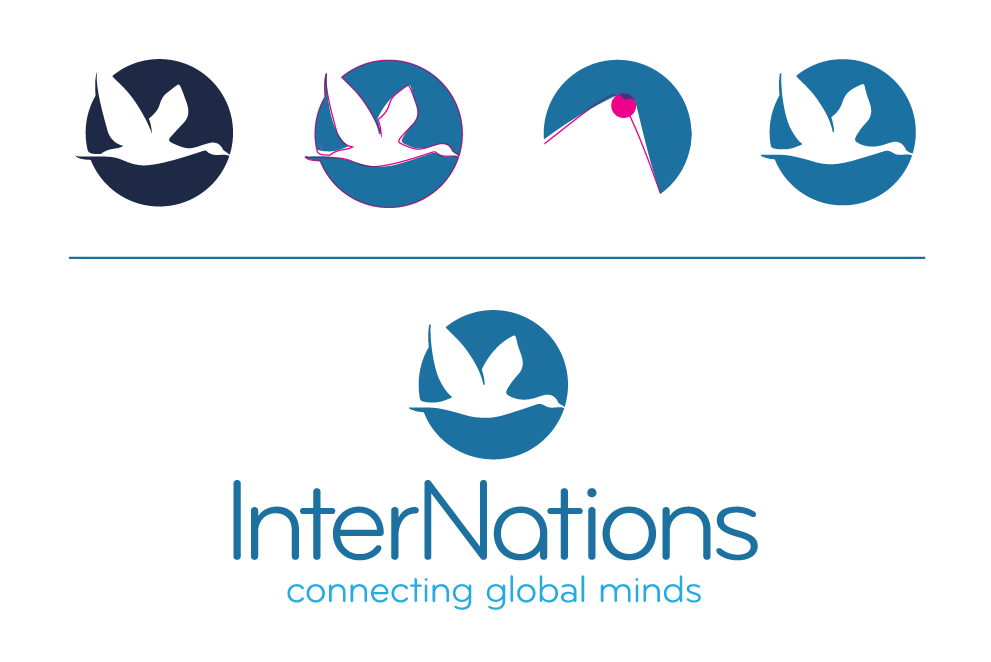
I also worked with the Content & Communications Department on designing our brand book, which is basically the “bible” of the InterNations brand. This was an important step for us. Creating the brand book was a true team effort: there were lots of drafts going back and forth before we agreed on the final version. Content-wise, I mainly gave input on the visual side, the chapter about how we look. Other people from CC were responsible for parts like the brand story, the tone of voice in written communication, and so on. It’s still an ongoing project. The infographics with the key facts about InterNations keep changing and need updating on a regular basis. So, the brand book remains a work in progress.
And what are you working on right now?
Currently, I’m working on the first part of the design requirements for this year’s Expat Insider survey — the outreach via email and social media, as the questionnaire will be sent and promoted in March. I just got started on the concept for the promotional banners today, but we haven’t decided on anything specific yet.
We might borrow and update some elements from the 2019 visual, which was a suitcase with a skyline inside. It performed really well last year, and I think the suitcase motif works quite nicely to promote a global expat survey. But it’s not something I’m completely happy with — I still have to think about it. When you work on a design project, you normally aren’t happy with your initial ideas. Very often, you need to review your first draft or leave it alone for a while and come back to it later. It’s just part of the creative process.
I’ve also been busy creating illustrations for the Project Management Department. I’m involved with their campaigns to promote our premium Albatross Membership with a free trial offer. There will be around six or seven of these campaigns throughout the year, and they need a new visual with a different theme for each.
The first campaign was all about Valentine’s Day, but I’m now working on some more illustrations for the upcoming ones. The next one will focus on friendship. That’s why I came up with an illustration that shows our six brand characters interacting in a friendly setting, taking a selfie together at an official event. And with the albatross being the symbol of InterNations, we might have a special campaign in honor of World Albatross Day later this year! But I can’t discuss the details of that yet.
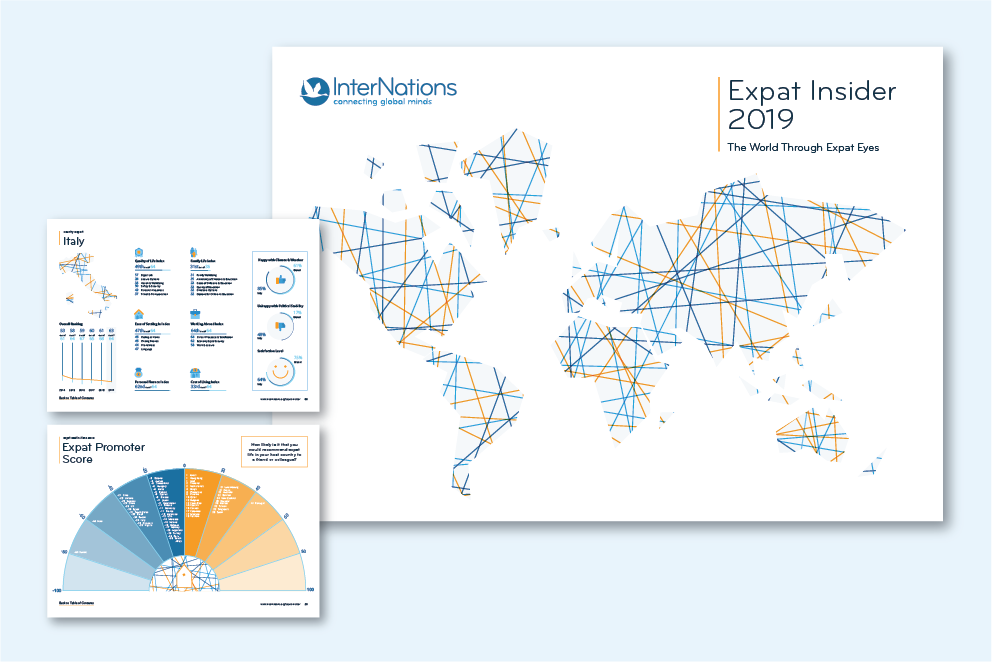
Any upcoming projects you’re especially excited about?
I’m really looking forward to the new visual concept for the Expat Insider survey report. It’s a project I really like — it’s a lot of work, but really exciting. I enjoy working on the same project from year to year to see how it develops over time. On the one hand, you have to respect the “DNA” of the design, so to speak. In the case of Expat Insider, we decided to keep a map of the world as the key visual. On the other hand, it shouldn’t look exactly the same; it needs to be fresh and different every time.
I was very happy with the final design of the Expat Insider 2019 survey report. It was a minimalist concept, just a stylized map and some crisscrossing lines, but I think it expresses the idea of connecting people, of expats interacting all over the globe, in a way that was very easy to understand. I love coming up with designs that are simple, yet meaningful. Good design isn’t just about creating something that “looks nice”. It should always convey a message; without meaning, it doesn’t make sense.
Which design-related skills would you like to acquire or improve in the future?
I’d like to have more opportunities to work on projects that involve animation in some way. I’ve done some basic animation before. For example, the Expat Insider 2019 video contained several animations, such as animated pictograms and maps. I supported Dennis, our videographer at the time, with these tasks, while he focused on editing the material. Sometimes, I also create animations for our social media posts, especially on Instagram. I would like to develop these skills even further and do more with them.
What do you like best about working at InterNations?
The company culture, specifically that we have the freedom to do whatever needs to be done. My boss is not hovering over my shoulder, constantly asking what I’m doing, and breathing down my neck. There is trust in the team members. I think you need to have this kind of independence in a creative job. Sometimes, the ideas just won’t come; you can’t force creativity.
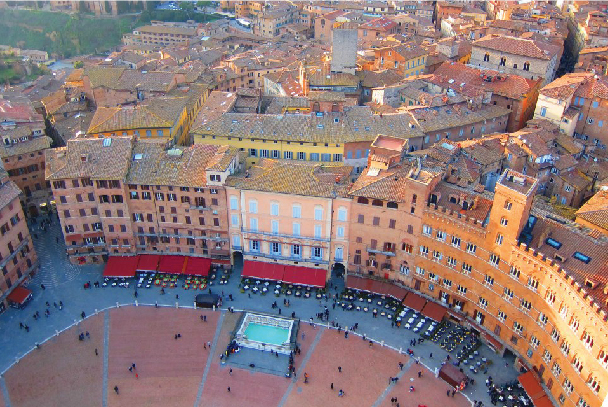
What did you do before moving to Germany in order to work at InterNations?
After graduating with a bachelor of arts in graphic design from Notre Dame University in Beirut, Lebanon, I worked abroad in Dubai for a few years. Then I moved to Italy to get my master’s degree in visual design from the Scuola Politecnica di Design in Milan; the city is one of the design capitals of the world. The degree program was in English, and I got a scholarship to boot — two birds, one stone.
Besides, I was drawn to Italian culture; I stayed in Italy for five years in total, working for several advertising agencies in Milan and Trentino-Alto Adige after graduation. In an agency, you have to handle different clients and different projects at the same time. My job at InterNations is actually the first time I’ve worked on the client side.
Though I’m Lebanese, Italy feels like “my” country. I’d gone there on vacation three times before relocating. I love all of Italy, but Tuscany is my favorite region, especially Florence and Siena. There’s something special about Siena in particular, its medieval cityscape, its atmosphere. I also had the chance to attend the famous Palio di Siena, probably the most popular horse-racing festival in the country.
While I didn’t speak any Italian at first, I found it easy to pick up, being fluent in French. It was much easier than learning German. You can manage with English in Munich, but in Italy, this would be impossible. Fortunately, it didn’t take me more than a year to switch from French. You just cannot live in Italy without speaking Italian. Even now, after living in Germany for almost three years, I still go to Bolzano quite often. It’s just three hours from Munich, and most of my Italian friends live there.
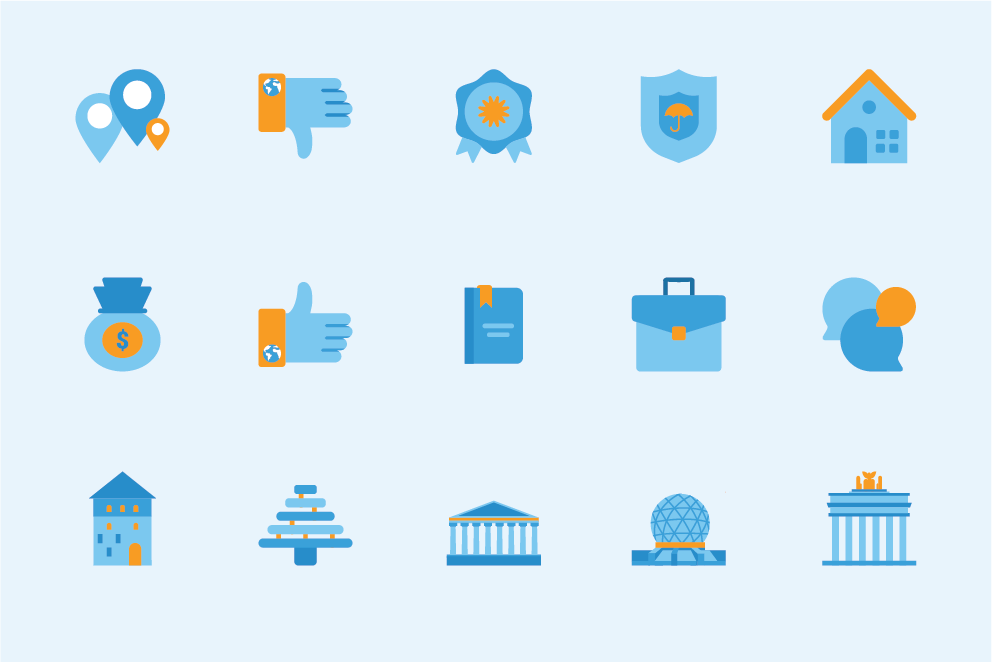
Where do you get your creative inspiration from? Do you have any role models in design?
What does creativity even mean? For me, it starts with curiosity. You have to be curious about everything and keep an eye on what’s going on around you. Whenever I walk down the street, posters or logos always attract my attention; and when I browse the internet, I sometimes look at a website and just love the design. I also read quite a few international design blogs and online magazines, such as étapes, a French magazine, or the Italian Progetto grafico.
Due to getting my degree in Milan, I also know a lot about Italian designers in general, for example, studio FM milano or Tassinari/Vetta, a well-known design office based in Trieste. I was taught by one of their designers, and I really admire their minimalist signature style. It’s just… wow. Amazing. But I also love what Sagmeister Inc., a famous firm in New York City, is doing and their whole approach to design — even if they did rebrand the look of our competitor Meetup.
And when I went to Iceland a while ago, for a three-day stopover on my way to the United States, I was astonished to find out how rich Reykjavik’s local design scene is, for such a relatively small city. Icelandic visual design also favors a deceptively simple style — minimalism full of meaning — which reflects my own personal preference.
Image credit: InterNations / private (Salim Salameh)
Indeed being a graphic design is not an easy job.